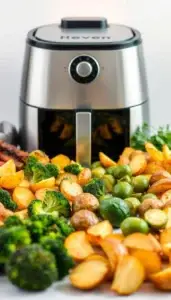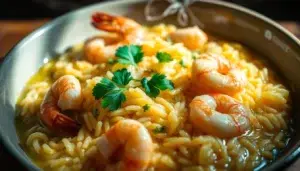Looking for a tasty and simple dish? A delicious seafood rice is great for a quick, satisfying meal.

This guide will show you how to make a seafood rice recipe. It’s a mix of fresh seafood and a warm, savory rice dish.
Follow this easy guide to make a dish that will wow your family and friends.
Key Takeaways
- Easy preparation steps for a delicious meal
- Combining freshness of seafood with savory rice
- A complete guide for a satisfying dish
- Tips for a flavorful and aromatic meal
- Perfect for a quick weeknight dinner or special occasion
The Magic of Seafood Rice
Seafood rice is more than a meal; it’s an experience. It connects us to the rich cultural heritage of different cuisines. Exploring its origins and variations is fascinating.
Cultural Origins of Seafood Rice Dishes
Seafood rice dishes come from coastal communities where seafood was plentiful. The way of combining seafood with rice varies worldwide. For example, in Spain, Paella from Valencia is a well-known dish.
In Asia, Japanese Omurice and Thai Khao Pad show the versatility of traditional seafood rice. These dishes highlight the diversity in enjoying seafood rice.
Health Benefits of Combining Seafood and Rice
Seafood and rice together offer great health benefits. Seafood is rich in protein and omega-3 fatty acids, good for the heart. Rice, like brown rice, adds fiber and minerals.
This mix makes a balanced meal for a healthy diet. When making homemade seafood rice, you can pick various seafood and adjust ingredients for your health.
Essential Ingredients for Your Seafood Rice Recipe
Making an easy seafood rice recipe starts with picking the best ingredients. The quality of your dish depends on the freshness and right choice of ingredients.
Selecting the Right Rice
The type of rice you pick can really change your seafood rice dish. Different rices have different textures, tastes, and how well they soak up flavors.
Short-Grain vs. Long-Grain Options
Short-grain rice sticks together well, perfect for dishes where you want the rice to cling. Long-grain rice stays fluffy and separate. For a best seafood rice, long-grain rice is better because it absorbs broth without getting mushy Seafood Rice Recipe.
Specialty Rice Varieties
Specialty rices like Arborio or jasmine can bring special flavors and textures to your seafood rice. Arborio, for example, gets creamy when cooked, making it great for a risotto-style seafood rice.
Fresh Seafood Selection
The freshness of your seafood is key for flavor and safety. Pick a mix of fish and shellfish that are fresh and sustainable.
Fish Options
For fish, use firm-fleshed types like cod or halibut. These fish cook well and add texture to your dish.
Shellfish Choices
Shellfish like shrimp, mussels, and clams are great additions. They add different textures and flavors, making your easy seafood rice even better.
Aromatics and Seasonings
Aromatics like onions, garlic, and saffron, along with seasonings, are key for flavor. Use them wisely to boost the dish without overwhelming the seafood.
Preparation Before Cooking
Before you start cooking your quick seafood rice, it’s essential to prepare all the necessary ingredients. This step ensures that your cooking process is smooth and efficient, resulting in a delicious and satisfying meal.
Cleaning and Preparing Seafood
Cleaning and preparing your seafood is a critical step. This involves several tasks to ensure your seafood is ready for cooking Seafood Rice.
Deveining Shrimp
To devein shrimp, start by rinsing them under cold water. Then, make a shallow cut along the top of the shrimp’s back and gently remove the vein. This process improves both the appearance and texture of the shrimp.
Cleaning Mussels and Clams
For mussels and clams, scrub the shells under cold running water to remove any dirt or debris. Discard any shells that are broken or remain open when tapped, as they may be spoiled.
Preparing Vegetables and Aromatics
Chop your vegetables and aromatics according to your recipe’s requirements. Typically, this includes dicing onions, mincing garlic, and chopping bell peppers. Freshness and cleanliness are key, so wash and dry all vegetables before chopping.
Measuring and Organizing Ingredients
Once your seafood, vegetables, and aromatics are prepared, measure out the required ingredients according to your recipe. Organize them in a way that makes them easily accessible during cooking. This step is vital for maintaining a smooth and efficient cooking process.
| Ingredient | Preparation Method | Measurement |
|---|---|---|
| Shrimp | Devein and rinse | 1 pound |
| Mussels | Scrub and debeard | 2 pounds |
| Clams | Scrub | 1 pound |
| Onion | Dice | 1 medium |
| Garlic | Mince | 3 cloves |
Step-by-Step Seafood Rice Recipe
Now that you have all your ingredients ready, it’s time to start making a delicious one-pot seafood rice. This recipe is easy to follow. It ensures your seafood rice turns out perfectly every time.
Creating the Flavor Base
The foundation of a great seafood rice recipe is its flavor base. This is built by sautéing aromatics and creating a rich broth.
Sautéing Aromatics
Start by heating oil in your pot over medium heat. Add onions, garlic, and bell peppers. Sauté until they’re softened and fragrant. This step is key for the flavor of your dish.
Building the Broth
Next, add your liquid ingredients, like broth and spices, to the pot. Bring it to a simmer. This broth will cook your rice and seafood, so it needs to be flavorful.

Cooking the Rice
Cooking the rice right is key to a great one-pot seafood rice. You need the right rice-to-liquid ratio and stirring techniques.
Proper Rice-to-Liquid Ratio
Make sure you use the right rice-to-liquid ratio. A 1:2 ratio is usually best, but it depends on the rice type.
Stirring Techniques
Stir your rice now and then to prevent sticking. But don’t stir too much, or it will become mushy.
Adding Seafood at the Right Time
The last step is adding your seafood. The timing and layering of seafood types are important for perfect cooking.
Layering Different Seafood Types
Start with seafood that takes the longest to cook, like mussels and clams. Then add quicker-cooking seafood like shrimp and fish.
Final Cooking and Resting
After adding all seafood, cook until it’s heated through. Then, remove the pot from the heat. Let it rest, covered, for a few minutes before serving.
Delicious Seafood Rice Recipe Variations
Seafood rice is a blank canvas for many flavors and ingredients. It’s loved by those who enjoy trying new dishes and making them their own.
Let’s look at some exciting variations for your next meal.
Spanish Paella-Style
Paella is a classic Spanish dish known for its bold flavors and colors. To make a seafood Paella, you need saffron rice, mixed seafood, and Spanish spices. Saffron adds a unique taste and yellow color.
Creamy Risotto with Seafood
For a creamy dish, try seafood risotto. It combines Arborio rice, seafood, white wine, and stock, topped with Parmesan cheese. The secret to a great risotto is stirring constantly and adding liquid slowly.
Asian-Inspired Seafood Rice
Asian dishes offer many seafood rice options. From Japanese seafood rice with soy sauce and sake to spicy versions in Southeast Asia. Adding ginger, garlic, and chili peppers gives it an Asian twist.
Cajun Jambalaya with Seafood
Jambalaya is a Louisiana favorite with rice, spicy meat or seafood, and veggies. For seafood, use shrimp, crab, and fish, seasoned with Cajun spices for a bold taste.
Here’s a comparison of these variations:
| Variation | Key Ingredients | Flavor Profile |
|---|---|---|
| Spanish Paella-Style | Saffron, seafood, Spanish spices | Rich, savory, slightly smoky |
| Creamy Risotto with Seafood | Arborio rice, seafood, Parmesan cheese | Creamy, rich, umami |
| Asian-Inspired Seafood Rice | Soy sauce, sake, ginger, garlic | Savory, slightly sweet, spicy |
| Cajun Jambalaya with Seafood | Seafood, Cajun spices, vegetables | Spicy, bold, hearty |
These variations show the wide range of seafood rice dishes. They offer inspiration for your cooking adventures. Whether you want something spicy, creamy, or rich, there’s a recipe for you.
Troubleshooting Your Seafood Rice
A delicious seafood rice dish is within your reach, and we’re here to help you overcome common cooking challenges. Whether you’re making a simple homemade seafood rice or an elaborate seafood rice recipe, issues can arise. Let’s tackle these problems together to ensure your dish turns out perfectly.
Fixing Undercooked or Overcooked Rice
If your rice is undercooked, add a bit more liquid and continue cooking until it’s tender. If it’s overcooked and mushy, try reducing the cooking time or liquid in your next attempt. For a quick fix, you can also spread the overcooked rice on a baking sheet to cool it down and stop the cooking process.
Adjusting Seasoning and Flavor
Taste your seafood rice as you go and adjust the seasoning. If it’s too bland, add more herbs or spices. If it’s too salty, a squeeze of fresh lemon juice can help balance the flavors. Remember, you can always add more seasoning, but it’s harder to remove excess salt or seasoning.

Rescuing Overcooked Seafood
Overcooked seafood can be tough and rubbery. To rescue it, chop the seafood into smaller pieces and mix it into the rice, or use it in a sauce or broth where texture isn’t as critical. Prevention is key, so keep an eye on your seafood while it’s cooking to avoid overcooking in the first place.
Addressing Texture Issues
Texture issues can arise from undercooked or overcooked ingredients. For a better texture, ensure your rice is cooked just right, and your seafood is tender but firm. If your dish is too dry, adding a bit of broth or sauce can help. If it’s too wet, simmering it for a few more minutes can help reduce the excess moisture.
| Issue | Solution |
|---|---|
| Undercooked Rice | Add more liquid and continue cooking |
| Overcooked Rice | Reduce cooking time or liquid next time |
| Overcooked Seafood | Chop into smaller pieces or use in sauce/broth |
| Texture Issues | Adjust cooking time for rice and seafood |
Serving and Pairing Suggestions
Now that you’ve learned to cook delicious seafood rice, it’s time to think about what to serve with it. The right side dishes and drinks can make your meal even better. Serving seafood rice is all about matching its flavors with the right sides and drinks.
Complementary Side Dishes
Pair your seafood rice with side dishes that offer different textures and tastes. A simple green salad or steamed veggies can be a nice contrast. You can also try garlic bread or grilled asparagus for extra flavor.
Wine and Beverage Pairings
The right drink can really bring out the flavors of your seafood rice. If you like white wine, try a crisp Sauvignon Blanc or Pinot Grigio. For something non-alcoholic, citrus-infused water or sparkling tea can refresh your palate.
Presentation Ideas for Special Occasions
For special events, make your seafood rice look good. Use a ring mold to shape it neatly. Add fresh herbs like parsley or dill, and a squeeze of lemon for color.
Storing and Reheating Leftovers
If you have leftovers, keep them in an airtight container in the fridge for up to two days. To reheat, add a bit of water or broth. Warm it over low heat, stirring now and then, until it’s hot.
Conclusion
You now have the tools to make a tasty seafood rice recipe. It’s easy and you can change it up to fit your taste. Just follow the steps in this article to start experimenting.
Seafood rice is perfect for any meal, big or small. You can mix and match seafood, spices, and seasonings to make it your own. It’s a great way to bring people together.
As you get better, you’ll make seafood rice that wows everyone. Don’t be shy to try new things. The endless possibilities mean every meal is a chance to create something special.
FAQ
What is the best type of rice to use for a seafood rice recipe?
Can I use frozen seafood for my seafood rice recipe?
How do I achieve the perfect rice-to-liquid ratio for seafood rice?
What are some common mistakes to avoid when cooking seafood rice?
Can I make a one-pot seafood rice recipe?
How can I make my seafood rice recipe spicy?
Is seafood rice a healthy meal option?
Can I prepare seafood rice in advance?
There are no reviews yet. Be the first one to write one.



